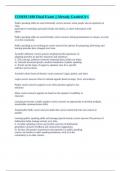COMM 1100 Final Exam || Already Graded A+.
Public speaking skills are used informally correct answers when people answer questions in
class,
participate in meetings, persuade friends and family, or share information with
others
Public speaking skills are used formally correct answers during presentations in classes, at work,
or in the community.
Public speaking as an evolving art correct answers the options for preparing, delivering, and
hearing speeches have changed over time.
Aristotle's Rhetoric correct answers emphasized the importance of
adapting speeches to specific situations and audiences.
ii. This concept, audience-centered communication, holds true today.
iii. Aristotle discussed proofs, another foundation of public speaking.
iv. Proofs are the types of support a speakers uses for a specific
audience and occasion.
Aristotle's three forms of rhetoric correct answers Logos, pathos, and ethos
Logos correct answers refers to rational appeals based on logic, facts, and analysis.
Pathos correct answers appeals occur when speakers appeal to our
emotions
Ethos correct answers appeals are based on the speaker's credibility or
character.
Learning to become a public speaker correct answers an opportunity to develop multiple,
transferable communication skills.
Transferable Skills correct answers skills that can be transferred from one context to
another.
Learning public speaking skills will manage speech anxiety correct answers The process of
habituation helps manage anxiety over time.
ii. A public speaking course can provide a process of habituation
grounded in positive feedback and constructive suggestions.
iii. In time, the positive experiences encountered in a public speaking
course can transfer to other speaking situations, such as in the
community or to other classes.
,Students will become better listeners correct answers One goal of a public speaking class is to
learn how to listen reciprocally, which is listening to others with full attention and an open mind
and they do the same with you.
Public speaking students are able to adapt to diverse audiences correct answers learn strategies
for getting to know their audiences.
learn how to build speaker credibility, correct answers which is how much the audience views
the speaker as competent, friendly, trustworthy, and dynamic.
learn how to find and use reliable information correct answers can be useful in all aspects of life.
learn how to organize ideas and information so
that listeners can follow and understand the speaker's message correct answers i. Patterns of
speech organization include chronological, spatial,
cause-and-effect, and problem-solution formats.
ii. Speakers use transitions and outlines while developing their
speeches.
iii. Organizing your ideas prior to speaking can give the ideas greater
impact with an audience.
Models of Human communication correct answers The transmission model portrays human
communication as information
flowing in a single direction from sender to receiver.
b. The interactional model expands on the transmission model by adding two
key elements: channel and feedback.
i. Messages pass from a sender through a channel, or mode of
communication, to a receiver or receivers. The channel might be a
person, telephone, text message, or webcam.
ii. Receivers respond to sources with feedback.
iii. Communication in the interactional model is two-way, with
messages going back and forth between the source and the
receiver.
The transactional model correct answers added three important elements: noise, context, and
environment
Noise correct answers any interference in the understanding of a message. It may be internal to
the speaker or external.
Environment correct answers includes all the outside forces that might affect
communication.
Channel correct answers refers to the mode or medium of communication. In today's world,
public speaking often involves multiple channels, including webcams, videoconferencing, digital
slides, text messaging, or e-mail.
, The Audience correct answers The audience is the intended recipients of the message. Today's
audiences may extend beyond the people who hear the speaker in person through the use of
digital recordings and webcams.
Feedback correct answers provides the speaker information about how an audience understands
the message based on their responses to the speech.
Context correct answers includes the physical setting for the speech and the occasion for the
speech.
Speaker correct answers the person who assumes the primary responsibility for conveying a
message in a public communication context
Speech Anxiety correct answers begins with uncertainty since, for most people, public speaking
is not an everyday occurrence.
Uncertain Reduction Theory correct answers posits that an individual's level of anxiety increases
when they face an uncertain or unfamiliar situation.
Strategies for managing Speech Anxiety correct answers A. Visualization involves thinking
through the sequence of events that make up the speech in a positive, detailed, concrete, and
step-by-step way.
1. Focus on what will go right in your speech
2. Visualize yourself giving a successful speech.
3. Use all of your senses to feel what will happen.
Re-Labeling correct answers occurs when you assign positive words or phrases to the physical
and emotional reactions associated with speech anxiety.
Relaxation techniques correct answers reduce the physical symptoms of stress.
Visualization correct answers Imagining a successful communication event by thinking through
a sequence of actions in a positive, concrete, step by step way.
several, useful strategies you can use prior to delivering your speech. correct answers Dress for
the occasion.
b. Keep all your notes and materials organized.
c. Arrive early.
d. Take calming breaths.
e. Warm up your voice.
f. Make sure all technical aspects of your speech are ready to go.
g. Concentrate on the other speakers
strategies you can use as you deliver your speech. correct answers a. Display your positive
attitude.




